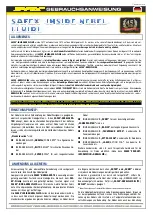
-29-
SCALLOP STITCH
ADJUSTING DECORATIVE PATTERNS
SEWING LIGHTWEIGHT FABRICS
When sewing lightweight fabrics, it is suggested that you use
interfacing on the backside of the fabric.
Stitch length
Stitch width
66
51
28
28
29 66
29 66
30 32 33
66
~
64
40
Right sides
together
Wrong sides
together
1
2
1
2
These stitches are used to sew a decorative edge on
garments and table cloths.
SCALLOP HEM
DECORATIVE SCALLOP EDGE
1. Fold the fabric with right sides together and sew
near the edge.
2. Cut the fabric along the seam leaving an allowance
of 3 mm(1/8 )for seaming. Notch the allowance.
3.Turn fabric with right sides out and gently push out
the curved seam press.
1. Place the fabric with wrong sides together and stitch
near the edge.
2. Trim along the outside edge of the stitching (being
careful not to cut the stitching).
3. Use seam sealant or fabric glue to secure edges
of the scallop stitching.
Use the open toe foot for continuous decorative stitch
patterns. An indentation on the underside permits the
flow of satin stitching and the open front allows clear
visibility.
To tailor decorative stitch patterns, adjust the length
and width of the pattern. More LED lights results in
a longer or wider stitch pattern. Fewer LED lights
gives you a shorter or narrower stitch pattern.
Experiment with sample fabric until you get the
desired length and width.
Note: Some stitch patterns do not have both length
and width adjustment.








































